Data Center Liquid Cooling Market Size
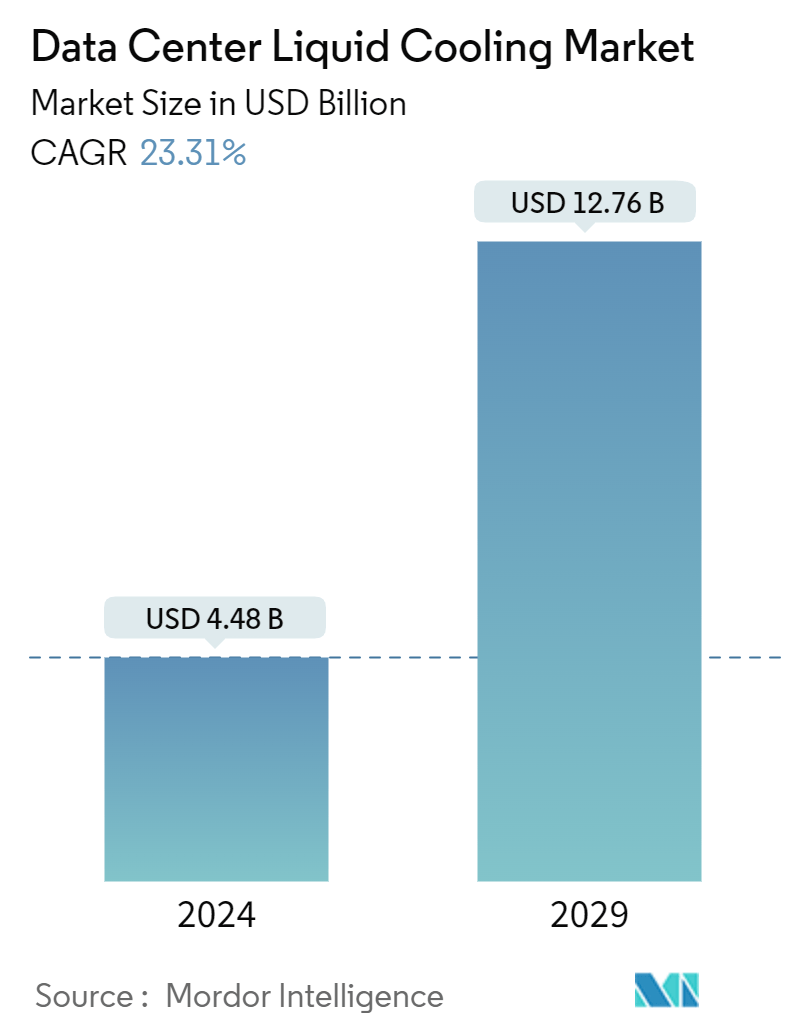
| Study Period | 2019 - 2029 |
| Market Size (2024) | USD 4.48 Billion |
| Market Size (2029) | USD 12.76 Billion |
| CAGR (2024 - 2029) | 23.31 % |
| Fastest Growing Market | Asia Pacific |
| Largest Market | North America |
Major Players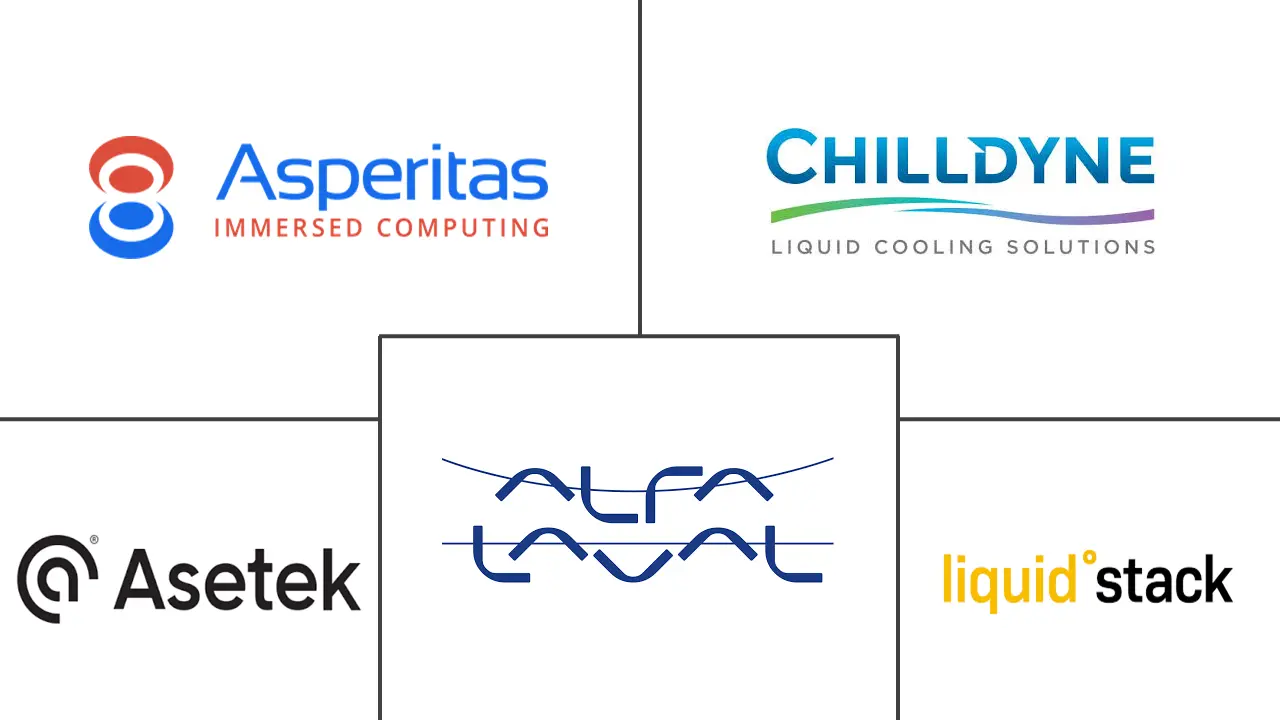
*Disclaimer: Major Players sorted in no particular order |
Data Center Liquid Cooling Market Analysis
The Data Center Liquid Cooling Market size is estimated at USD 4.48 billion in 2024, and is expected to reach USD 12.76 billion by 2029, growing at a CAGR of 23.31% during the forecast period (2024-2029).
The market for data center liquid cooling is experiencing rapid growth, driven by the increasing demand for green data centers and the need for more efficient thermal management solutions. Rapid adoption of high-performance computing, artificial intelligence, and machine learning workloads is providing significant impetus to this market growth. As rack densities continue to increase, traditional air-cooling methods are becoming insufficient, leading to a paradigm shift towards liquid cooling solutions. This trend is further accelerated by the global focus on energy efficiency and sustainability, with data centers accounting for nearly 2% of global energy consumption and projected to reach 8% by 2030 if left unchecked.
Liquid cooling technologies are emerging as a critical solution to address the challenges of high-density computing and energy efficiency in data centers. Direct-to-chip and immersion cooling systems are gaining traction, with the direct-to-chip segment holding a 66.78% market share in 2023. These advanced cooling methods can handle rack densities exceeding 30kW, with some solutions supporting up to 300kW per rack. The adoption of liquid cooling can result in significant energy savings, with studies showing up to 70% reduction in cooling power needs compared to traditional air-cooling systems.
As data center operators strive to improve their Power Usage Effectiveness (PUE) and reduce their carbon footprint, liquid cooling is poised to play a crucial role in shaping the future of data center infrastructure.
Data Center Liquid Cooling Market Trends
IT Infrastructure Growth Fuels Data Center Liquid Cooling Demand
The rapid expansion of digital data is significantly driving the data center cooling market. Global data production exceeded 64 zettabytes in 2021 and is projected to reach an astounding 180 zettabytes by 2025. This exponential growth necessitates a proportionate increase in data center capacity, creating a pressing need for efficient cooling solutions. The adoption of cloud computing and big data analytics further amplifies this demand, with industry giants like Amazon Web Services, Microsoft Azure, and Google Cloud Platform continuously expanding their data center footprints.
Emerging economies are playing a crucial role in the growth of data center cooling market. Countries like India, Hong Kong, China, and Indonesia are experiencing significant developments in IT infrastructure. India's IT and infrastructure sectors are poised to be central to its goal of becoming a USD 10-trillion economy by 2030. The Indian government's initiatives, such as introducing a data center policy and state-level incentives, are fostering the growth of data center parks nationwide. This surge in data center construction, particularly in high-traffic urban areas, is driving the demand for advanced cooling technologies that can accommodate high-density operations while minimizing the physical footprint.
Green Data Centers Propel Adoption of Liquid Cooling Solutions
The emergence of green data centers is a key driver for the data center liquid cooling market. With data centers projected to account for 33% of global electricity production by 2025, there's an urgent need to shift towards more sustainable operational practices. Green data centers prioritize energy efficiency and reduced carbon footprints, aligning with stringent government regulations on energy consumption. For instance, the European Union has set targets to achieve a 32% share of renewable energy in energy consumption by 2030, encouraging the adoption of energy-efficient cooling technologies.
Liquid cooling solutions are gaining traction in green data centers due to their superior energy efficiency. Direct liquid cooling (DLC) can reduce cooling power needs by up to 70% compared to traditional air-based systems. This efficiency translates to significant cost savings and aligns with sustainability goals. Major tech companies are leading this shift; for example, Google's data centers operate at a power usage effectiveness (PUE) of less than 1.1, significantly lower than the industry average of 1.58 in 2023. The integration of renewable energy sources in data centers further complements liquid cooling technologies, creating a synergy that drives both energy efficiency and sustainability in the data center industry.
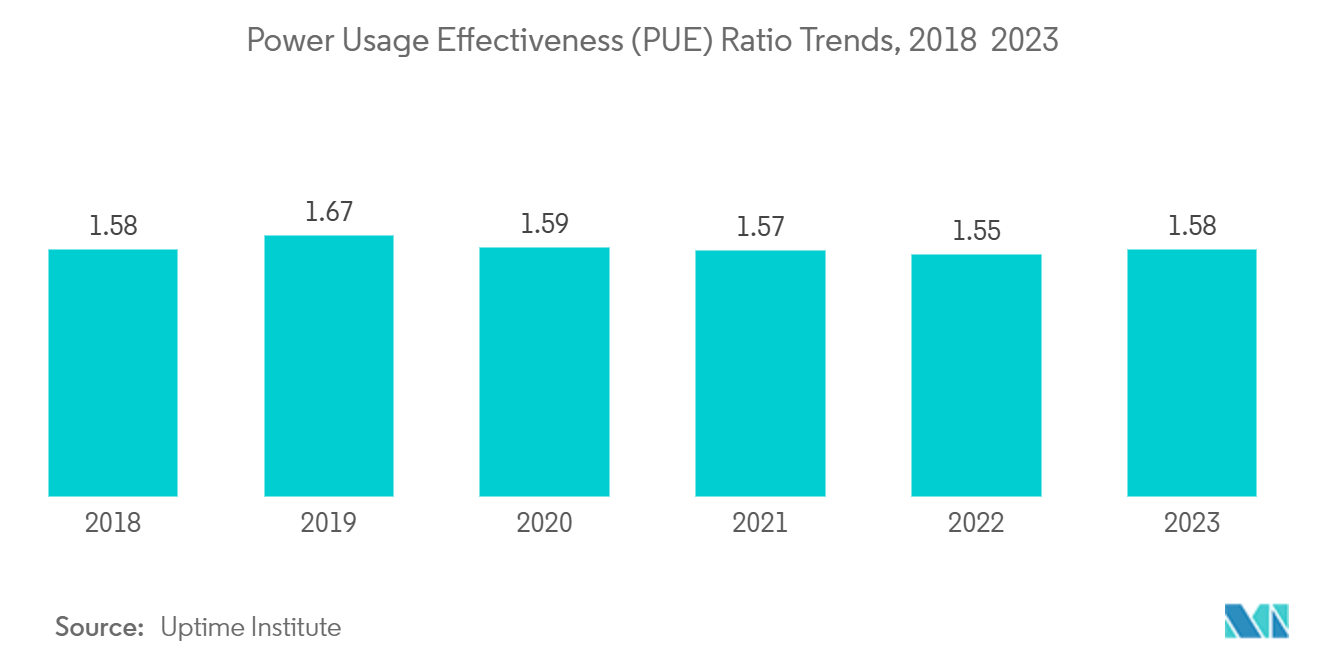
Data Center Liquid Cooling Market Cooling Segments
Data Center Direct Cooling (Immersion Cooling) Segment Analysis
Immersion cooling is gaining significant traction in the data center industry due to its ability to handle high-density computing and reduce energy consumption. This method involves submerging IT equipment directly in a dielectric fluid, which efficiently removes heat from the components. The direct cooling or immersion cooling market is projected to grow at a CAGR of 26.15% p.a. from 2024 to 2029. This impressive market growth rate underscores the increasing adoption of immersion cooling technologies in data centers worldwide.
Immersion cooling is particularly effective in three main applications: High-Performance Computing (HPC), Edge Computing, and Cryptocurrency Mining. HPC environments benefit greatly from immersion cooling due to their high-power densities and thermal management requirements. As edge computing deployments grow, immersion cooling offers a compact and efficient solution for managing heat in space-constrained environments. The intense computational requirements of cryptocurrency mining make immersion cooling an attractive option for maintaining optimal operating temperatures and efficiency.
Two primary types of fluids are used in immersion cooling systems: fluorocarbon-based fluids and hydrocarbon fluids. Fluorocarbon-based fluids offer high chemical and thermal stability. They are non-flammable, non-oil-based, and have low toxicity. Examples include 3M's Fluorinert Electronic Liquids, which are widely used in the industry. Hydrocarbon fluids, on the other hand, include synthetic fluids that are biodegradable and environmentally friendly. Companies like Shell and ExxonMobil are developing new hydrocarbon-based cooling fluids to meet the growing demand for sustainable cooling solutions in data centers.
Indirect Cooling (Direct-to-Chip) Segment Analysis
Direct-to-chip cooling, also known as liquid-to-chip or cold plate cooling, is becoming increasingly popular in data centers. This method involves bringing liquid coolant directly to the processor or other high-heat components using a cold plate. The indirect cooling segment, which includes direct-to-chip cooling, currently dominates the liquid cooling in data centers, holding a substantial 79.5% share of the market as of 2023. This significant market share demonstrates the widespread adoption and trust in indirect cooling technologies among data center operators.
Direct-to-chip cooling is particularly effective for AI and Machine Learning workloads, high-density GPU clusters, and enterprise and hyperscale data centers. The high computational requirements of AI and ML workloads make direct-to-chip cooling an attractive option for managing heat efficiently. As GPU densities increase in data centers, direct-to-chip cooling provides a more efficient cooling solution compared to traditional air cooling. Many large-scale data center operators are adopting direct-to-chip cooling to improve energy efficiency and support higher power densities.
Recent technological advancements in direct-to-chip cooling include microchannel cooling, micro-convective cooling, and two-phase direct-to-chip cooling. Microchannel cooling technology uses small fluid channels within cold plates to improve heat transfer efficiency. Micro-convective cooling, developed by companies like JetCool, uses arrays of small fluid jets to bring coolant directly to the surface of heat-generating devices. Two-phase direct-to-chip cooling is an advanced method that allows for even higher heat dissipation by utilizing the phase change of the coolant.
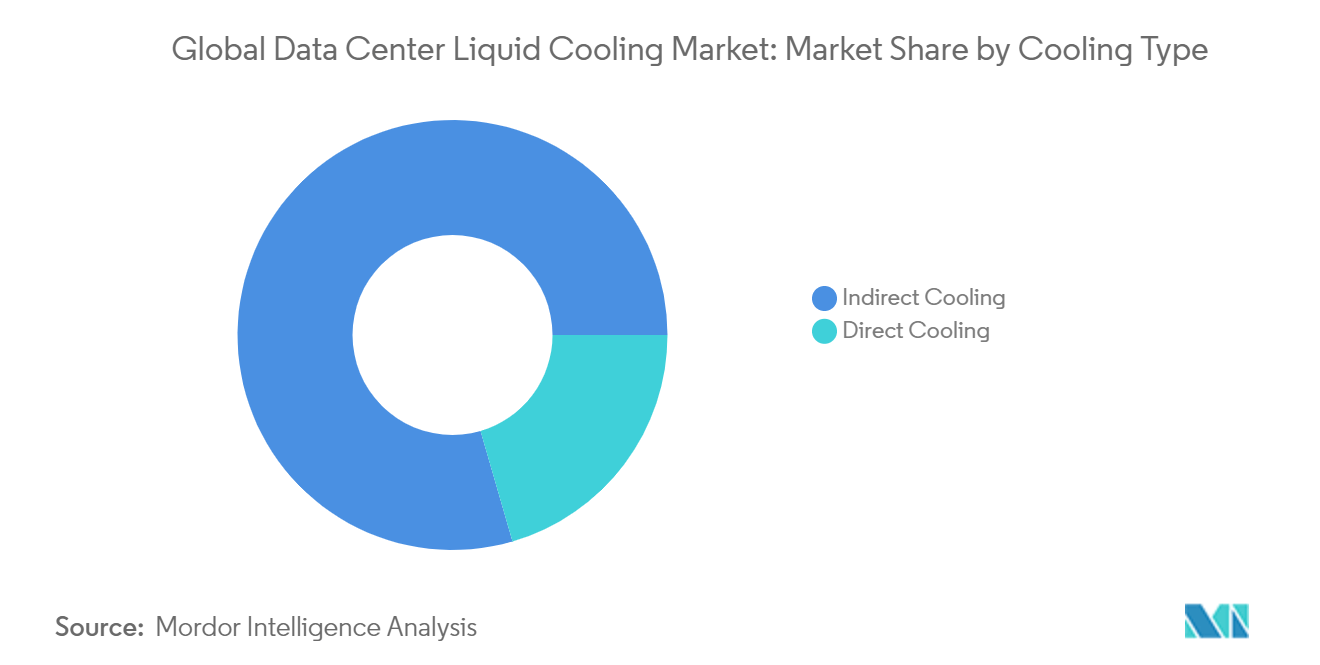
Global Data Center Liquid Cooling Market Geography Segments
North America Data Center Liquid Cooling Market Analysis
North America stands as a pioneer in adopting advanced technologies, particularly in the data center liquid cooling sector. The region's market is characterized by substantial investments in liquid immersion and direct liquid cooling solutions. As of 2023, North America held the largest market share of 40.58% in the global data center liquid cooling market, valued at USD 1,269.3 million. This dominant position underscores the region's leadership in embracing innovative cooling technologies.
The emergence of 5G networks has catalyzed the importance of edge data centers, with the United States leading the charge. Companies like EdgePresence, EdgeMicro, and American Towers are actively investing in these centers, driving the demand for efficient cooling solutions. The United States, as the largest market for data center operations, is experiencing exponential growth in internet usage across businesses and consumers. Mobile data traffic in the country has seen a significant increase, from 1.26 exabytes per month in 2017 to 7.75 exabytes per month by 2022, with expectations to triple further by 2030.
Recent economic incentives and tax benefits have been crucial drivers for data center construction in the United States. Approximately 27 states are leveraging these factors to attract data center projects, indicating a government-led initiative to construct new mega data centers or renovate existing ones. This trend is creating a robust demand for liquid cooling in data centers, as traditional air-cooled systems reach their maximum economic cooling capability in the region.
Europe Data Center Liquid Cooling Market Analysis
Europe's data center liquid cooling market is being shaped by the proliferation of AI, edge computing, 5G, and a strong focus on reducing carbon emissions. The market in Europe is forecasted to grow at a CAGR of 22.01% from 2024 to 2029, indicating significant expansion in the adoption of liquid cooling technologies. This growth rate reflects the region's commitment to innovative and energy-efficient cooling solutions.
The European market is characterized by a strong emphasis on renewable energies to power data centers. For instance, Spain has seen the deployment of its first sustainable Liquid Immersion Cooling cluster that relies on renewable energies as a secondary cooling system. This smart grid, powered by a biomass plant, significantly reduces fossil fuel energy consumption and CO2 emissions, aligning with the region's sustainability goals.
Partnerships between global cooling solution providers and regional data center infrastructure companies are facilitating the adoption of immersion cooling technologies across Europe. These collaborations aim to reduce energy use, solve power and space density challenges, cut energy cooling costs, and enable the placement of high-performance computing close to where it's needed. The region is witnessing a shift towards operating at densities in the triple-figure kilowatt range, necessitating the adoption of direct liquid cooling and immersion cooling solutions.
Asia-Pacific Data Center Liquid Cooling Market Analysis
The Asia-Pacific region is experiencing rapid growth in the data center liquid cooling market, with a forecasted CAGR of 24.32% from 2024 to 2029. This impressive growth rate positions APAC as one of the fastest-growing regions in the global market, driven by the exponential increase in demand for digital infrastructure. Countries like China and India are at the forefront of this growth, with significant investments in data center technologies.
China, in particular, is focusing on taking the lead over global peers in data center construction, with larger enterprises scaling up their facilities to ensure stability and reliability of data services. The application of 5G, wearable devices, Internet of Things, and artificial intelligence is spurring a burgeoning demand for computing power in the region. This has led to the adoption of accelerator processors in enterprise data centers, which have higher cooling requirements. The need for cooling solutions that can handle up to 200W or more is driving the usage of immersive cooling technology in the region's data centers.
India's digital transformation, propelled by the proliferation of affordable smartphones and connectivity, is creating significant opportunities for data center liquid cooling solutions. The government's Digital India Program and proposed laws on data localization are accelerating the growth of data center infrastructure. Moreover, the push for environmental sustainability across Asia is a critical factor in the region's adoption of immersion cooling technologies, addressing challenges such as hot and humid climates, expensive properties, and price sensitivity.
Rest of the World Data Center Liquid Cooling Market Analysis
The Rest of the World region, encompassing Latin America, the Middle East, and Africa, presents a growing market for liquid cooling in data centers. While this region currently holds a smaller market share compared to North America, Europe, and Asia-Pacific, it is showing promising growth potential with a CAGR of 19.75% from 2024 to 2029.
Adoption of liquid cooling for data centers in these regions is driven by the increasing presence of major cloud players entering these untapped markets. The hot and humid weather conditions in many of these areas make cooling solutions like immersion cooling a priority for data centers. In the Middle East, initiatives like Saudi Arabia's Vision 2030 have attracted technology giants such as Google, Microsoft, and IBM to set up data centers in the region. This influx of global players is intensifying competition and driving local data center providers to enhance their facilities, creating a positive impact on the liquid cooling market.
Latin America, particularly Brazil, is emerging as a significant market for data center liquid cooling solutions. Brazil holds the largest number of data centers in the region and is witnessing increased investment from new players. The country's focus on digital transformation strategies, especially among small and medium-sized companies, is driving the adoption of technologies such as analytics, cloud computing, and artificial intelligence. This digital shift is expected to fuel the demand for efficient cooling solutions in data centers across the region.
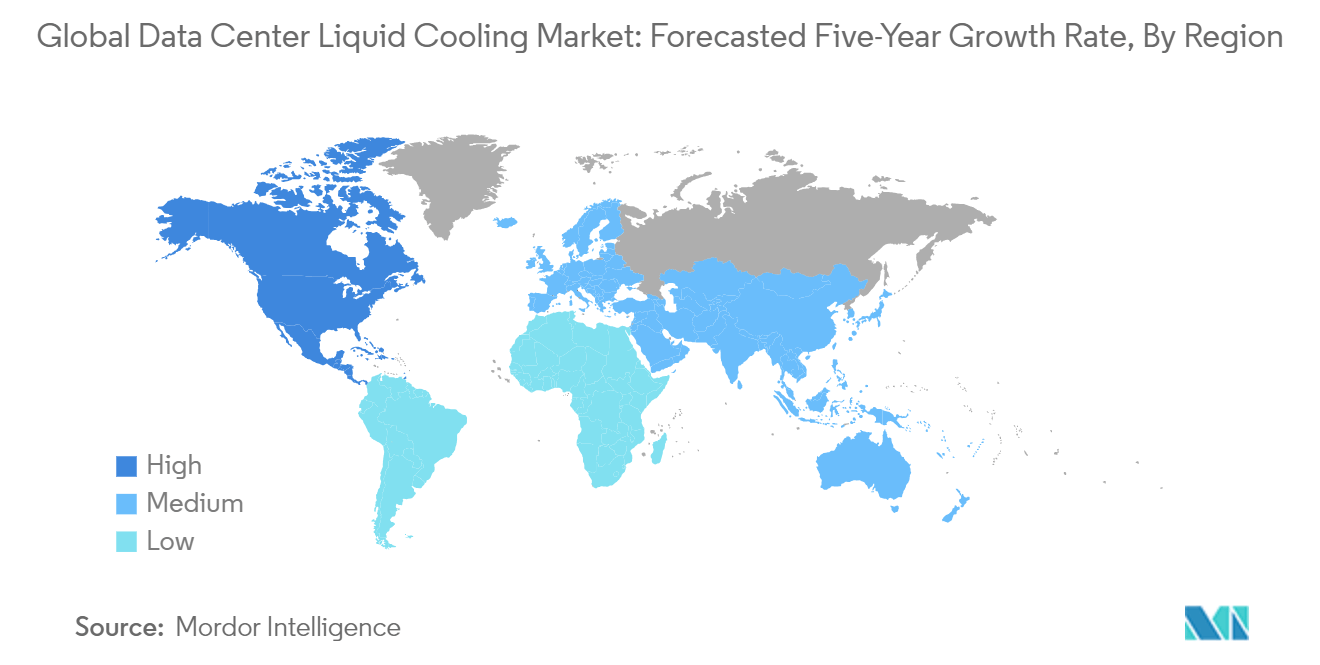
Global Data Center Liquid Cooling Industry Overview
Top companies in data center liquid cooling market
- Schneider Electric
- Vertiv Group Corp.
- Asetek
- CoolIT Systems
- Iceotope Technologies
- LiquidStack
- Alfa Laval
- Asperitas
- Lenovo Group Limited
- Fujitsu Ltd.
Data center liquid cooling market consolidating
The data center liquid cooling market is characterized by a mix of global conglomerates and specialized cooling technology providers. Market consolidation is evident through strategic partnerships and investments. M&A trends show larger companies acquiring innovative startups to expand their liquid cooling portfolios. The market is witnessing increased collaboration between cooling technology vendors, data center operators, and IT hardware manufacturers to develop integrated solutions.
Innovation driving competitive advantage
Major players in the market are focusing on product innovation and operational agility to maintain their competitive edge. Data Center cooling companies are developing advanced liquid cooling solutions, including direct-to-chip cooling, immersion cooling, and rear-door heat exchangers. Strategic moves include expanding manufacturing capabilities, investing in R&D, and forming partnerships to enhance technological offerings. Expansion into new geographical markets and targeting high-growth sectors like AI and edge computing are common trends among leading companies.
Sustainability and efficiency key to future success
Future success in the data center liquid cooling market will depend on developing energy-efficient and environmentally sustainable solutions. Incumbents must focus on scalable, cost-effective technologies to increase market share. Liquid cooling companies can gain ground by addressing specific end-user needs in high-density computing environments. The market's future is influenced by increasing end-user concentration in sectors like cloud computing and AI. Substitution risk from advanced air-cooling technologies remains low due to liquid cooling's superior efficiency. Potential regulatory impacts, particularly around environmental standards, may drive further innovation in coolant technologies and system designs.
Data Center Liquid Cooling Market Leaders
-
Alfa Laval Corporate AB
-
LiquidStack Inc.
-
Asetek Inc. A/S
-
Asperitas
-
Chilldyne Inc.
*Disclaimer: Major Players sorted in no particular order
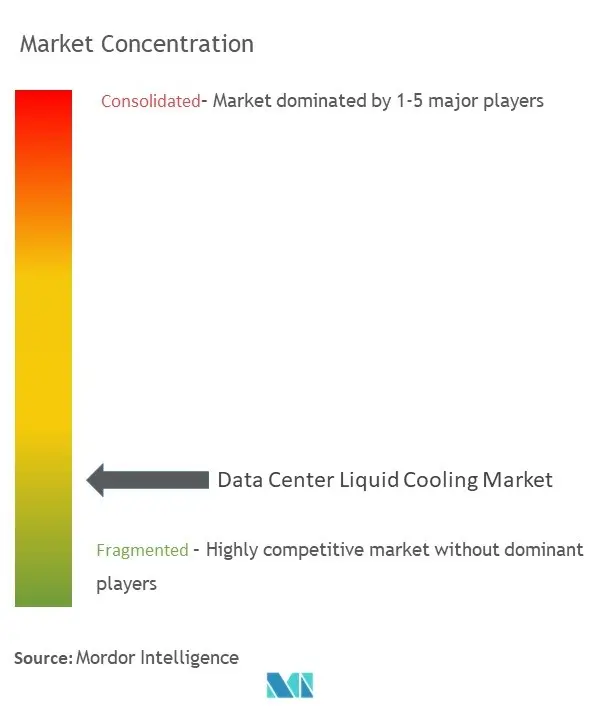
Data Center Liquid Cooling Market Report - Table of Contents
1. INTRODUCTION
- 1.1 Study Assumptions and Market Definition
- 1.2 Scope of the Study
2. RESEARCH METHODOLOGY
3. EXECUTIVE SUMMARY
4. MARKET INSIGHTS
-
4.1 Evolution Of Data Center Cooling
- 4.1.1 Air Conditioners/Handlers
- 4.1.2 Chillers And Economizer Systems
- 4.1.3 Liquid Cooling Systems
- 4.1.4 Row/Rack/Ddoor/Over-head Cooling Systems
- 4.2 Overview of Data Center Cooling Market
- 4.3 Energy Consumption, Computing Density Metrics and Key Considerations For Liquid Cooling
- 4.4 Industry Stakeholder Analysis
-
4.5 Industry Attractiveness - Porter's Five Forces Analysis
- 4.5.1 Bargaining Power of Buyers
- 4.5.2 Bargaining Power of Suppliers
- 4.5.3 Threat of New Entrants
- 4.5.4 Degree of Competition
- 4.5.5 Threat of Substitutes
5. MARKET DYNAMICS
-
5.1 Market Drivers
- 5.1.1 Development of IT Infrastructure in the Region
- 5.1.2 Emergence of Green Data Centers
-
5.2 Market Restraints
- 5.2.1 Costs, Adaptability Requirements, and Power Outages
- 5.3 Assessment of COVID-19 Impact on the Industry
6. OUTLOOK OF REAR DOOR HEAT EXCHANGERS (RDHX) IN DATA CENTERS
- 6.1 Technical Comparison of RDHx and Liquid Cooling (Direct and Indirect) in Data Centers
- 6.2 Recent Developments by Data Center Cooling Technology Vendors in the Context Of RDHx and Liquid Cooling Market
- 6.3 Approximate Global Market Share of RDHx (in USD Billion)
- 6.4 List of Key RDHx Vendors (Business Overview, Portfolio and Recent Developments)
7. DIRECT COOLING OR IMMERSION COOLING MARKET
- 7.1 Direct Cooling Market Overview And Estimate
-
7.2 Immersion Cooling - Key Application
- 7.2.1 High-performance Computing
- 7.2.2 Edge Computing
- 7.2.3 Cryptocurrency Mining
-
7.3 Immersion Cooling Fluids
- 7.3.1 Fluorocarbon-based Fluids
- 7.3.2 Hydrocarbons Fluids
8. INDIRECT OR DIRECT-TO-CHIP COOLING MARKET
- 8.1 Indirect Cooling Market Overview and Estimates
- 8.2 Indirect or Direct-to-chip Cooling Key Applications
9. MARKET SEGMENTATION
-
9.1 By Geography***
- 9.1.1 North America
- 9.1.2 Europe
- 9.1.3 Asia
- 9.1.4 Australia and New Zealand
- 9.1.5 Latin America
- 9.1.6 Middle East and Africa
10. COMPETITIVE LANDSCAPE
-
10.1 Company Profiles*
- 10.1.1 Alfa Laval Corporate AB
- 10.1.2 LiquidStack Inc.
- 10.1.3 Asetek Inc. A/S
- 10.1.4 Asperitas
- 10.1.5 Chilldyne Inc.
- 10.1.6 CoolIT Systems Inc.
- 10.1.7 Fujitsu Ltd.
- 10.1.8 Mikros Technologies
- 10.1.9 Kaori Heat Treatment Co. Ltd
- 10.1.10 Lenovo Group Limited
- 10.1.11 LiquidCool Solutions Inc.
- 10.1.12 Midas Green Technologies
- 10.1.13 Iceotope Technologies Ltd
- 10.1.14 USystems Ltd (Legrand Group)
- 10.1.15 Rittal GmbH & Co. KG
- 10.1.16 Schneider Electric
- 10.1.17 Submer Technologies & Submer Inc.
- 10.1.18 Vertiv Group Corp.
- 10.1.19 Wakefield Thermal Solutions Inc.
- 10.1.20 Wiwynn Corporation
- 10.1.21 3M Company
- 10.1.22 Engineered Fluids Inc.
- 10.1.23 Green Revolution Cooling Inc.
- 10.1.24 Solvay SA
11. COOLING TECHNOLOGY INNOVATIONS ACROSS THE VALUE CHAIN
12. INVESTMENT ANALYSIS AND MARKET OUTLOOK
** Subject To AvailablityData Center Liquid Cooling Industry Segmentation
Data center liquid cooling involves the installation of IT hardware, such as memory, drives, and CPUs, directly into non-conductive dielectric liquids, which cool the system. The heat generated from these systems is directly transferred to coolants, reducing the need for active cooling components, such as heat sinks, fans, and interface materials commonly used for air cooling.
The data center liquid cooling market is segmented by type (indirect or direct-to-chip cooling, direct cooling or immersion cooling, rare door heat exchanger), application (high-performance computing, edge computing, cryptocurrency mining), and geography (North America, Europe, Asia-Pacific, and Rest of the World). The market size and forecasts are provided in terms of value (USD) for all the above segments.
| By Geography*** | North America |
| Europe | |
| Asia | |
| Australia and New Zealand | |
| Latin America | |
| Middle East and Africa |
Data Center Liquid Cooling Market Research FAQs
How big is the Data Center Liquid Cooling Market?
The Data Center Liquid Cooling Market size is expected to reach USD 4.48 billion in 2024 and grow at a CAGR of 23.31% to reach USD 12.76 billion by 2029.
What is the current Data Center Liquid Cooling Market size?
In 2024, the Data Center Liquid Cooling Market size is expected to reach USD 4.48 billion.
Who are the key players in Data Center Liquid Cooling Market?
Alfa Laval Corporate AB, LiquidStack Inc., Asetek Inc. A/S, Asperitas and Chilldyne Inc. are the major companies operating in the Data Center Liquid Cooling Market.
Which is the fastest growing region in Data Center Liquid Cooling Market?
Asia Pacific is estimated to grow at the highest CAGR over the forecast period (2024-2029).
Which region has the biggest share in Data Center Liquid Cooling Market?
In 2024, the North America accounts for the largest market share in Data Center Liquid Cooling Market.
What years does this Data Center Liquid Cooling Market cover, and what was the market size in 2023?
In 2023, the Data Center Liquid Cooling Market size was estimated at USD 3.44 billion. The report covers the Data Center Liquid Cooling Market historical market size for years: 2019, 2020, 2021, 2022 and 2023. The report also forecasts the Data Center Liquid Cooling Market size for years: 2024, 2025, 2026, 2027, 2028 and 2029.
What drives the Data Center Liquid Cooling Market?
Key drivers of the Data Center Liquid Cooling Market are a) Increasing data center densities b) Need for energy-efficient cooling solutions c) Rising adoption of high-performance computing (HPC)
Global Data Center Liquid Cooling Industry Report
Data Center Liquid Cooling Market Research
Our comprehensive industry analysis offers critical insights into data center cooling trends, growth factors, and competitive dynamics shaping the sector. With rising demands for energy-efficient solutions driven by the expansion of high-performance computing and AI workloads, data centers are increasingly turning to liquid cooling technologies to manage high-density operations. This report provides an in-depth examination of cooling systems, including direct-to-chip and immersion cooling, focusing on their market performance across key global regions. The insights gathered are essential for stakeholders seeking to optimize operational efficiency, sustainability, and infrastructure scalability.
The report covers an extensive array of data, including data center cooling trends, growth projections, and detailed segmentation by region, cooling type, and application. With detailed industry information and statistics, it highlights emerging technologies, evolving energy standards, and critical developments in cooling solutions. Stakeholders benefit from the market forecast and expert analysis on future growth opportunities, all compiled into a user-friendly report pdf format for easy reference and strategic decision-making.



